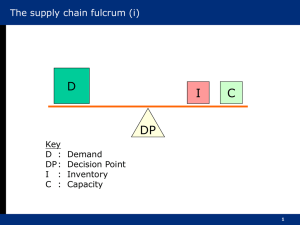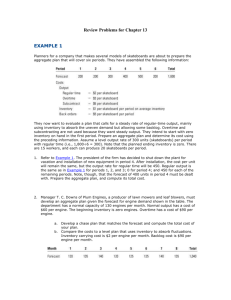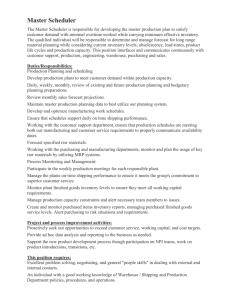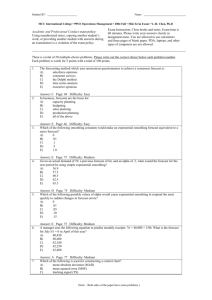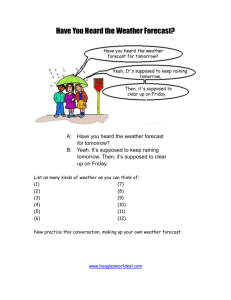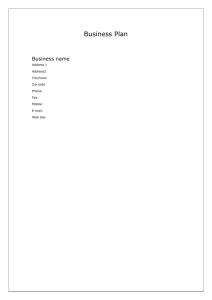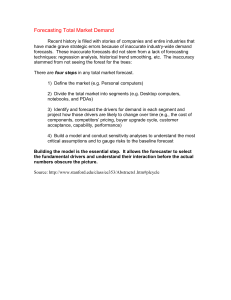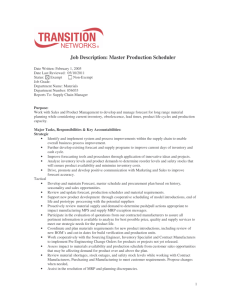Capacity Management - farrell
advertisement
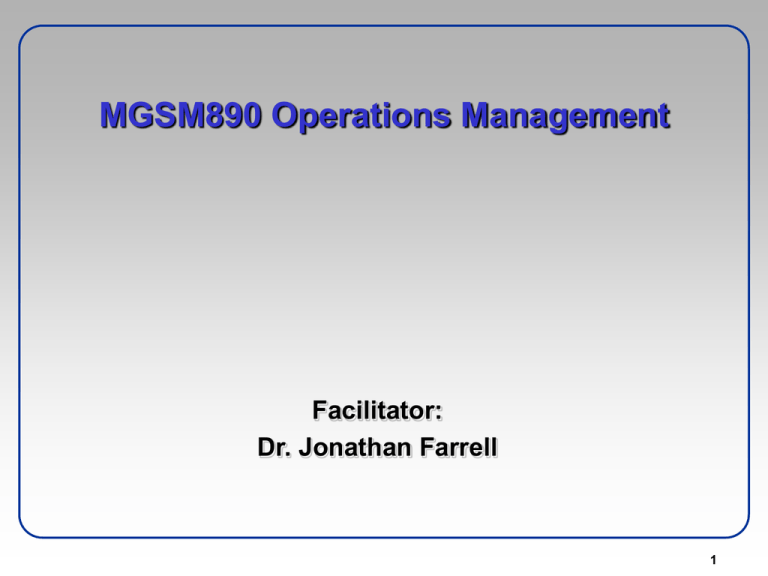
MGSM890 Operations Management Facilitator: Dr. Jonathan Farrell 1 This Evening’s Program • Capacity Planning & Control – – – – Aggregate Planning Capacity versus Demand The Planning Process Managing Capacity & Demand • Case Study – British Airways London Eye (pp 393,394) • Exercises – Capacity Management (refer to the Folder of Readings) 2 Some Definitions • Capacity is the available time for production and / or the maximum number of items that can be manufactured or delivered within a given time. • A Bottleneck occurs when capacity is less than the demand placed on it. • A capacity-constrained resource (CCR) is a resource where the capacity is close to demand placed it. 3 Capacity planning and control Supply The operation Operations resources Demand Availability of capacity to deliver products and services Required availability of products and services The market Customer requirements 4 Capacity Planning Horizons Long range plans Facilities – major capital expenditures Locations Aggregate (Intermediate) plans Minor equipment purchasing Materials requirements Work force size Production rates Detailed (short-term) schedules Daily, weekly schedules People - machine assignments 5 The Planning Process Market Demand Forecast Starting Inventory Aggregate Plans Ending inventory Overtime Hiring and layoffs Subcontracting Actual Demand Material Procurement People-Machine Assignment 6 Causes of seasonality Climatic Festive Behavioural Political Financial Social Construction materials Travel services Beverages (beer, cola) Holidays Foods (ice-cream, Christmas cake) Tax processing Clothing (swimwear, shoes) Doctors (influenza epidemic) Gardening items (seeds, fertilizer) Sports services Fireworks Education services 7 Not worked (unplanned) Loading time Total operating time Availability losses Net operating time Speed losses Quality Valuable operating time losses Availability rate = a = total operating time / loading time Set-up and changeovers Breakdown failure Performance rate = p = net operating time/total operating time Equipment “idling” Slow running equipment Quality losses Quality rate = q = valuable operating time / net operating time 8 Simple queuing system Server 1 Distribution of processing times Distribution of arrival times Rejecting Balking Reneging Server 2 Source of customers Boundary of system Queue or “waiting line” Served customers Server m 9 Simple queuing system Low variability narrow distribution of process times Time High variability wide distribution of process times Time 10 Period t Period t - 1 Period t + 1 Current capacity Updated estimates forecasts Outcome Actual demand and actual capacity Shortages Queues Inventory Costs Revenues Working capital Customer satisfaction etc Decision How much capacity next period? Current capacity Updated estimates forecasts Capacity level Outcome Actual demand and actual capacity? Shortages Queues Inventory Decision How much capacity next period? Costs Revenues Working capital Customer satisfaction etc 11 Short-term outlook POOR POOR NORMAL GOOD Outlook < 1 Outlook = 1 Outlook > 1 Lay off staff Delay any action Hire temporary staff Outlook < 1 Long-term outlook NORMAL Short-time Idle time Do nothing Outlook > 1 Outlook = Overtime Hire temporary staff Outlook = 1 GOOD Overtime Make for inventory Hire and make for inventory Short-time Start to recruit Hire staff Forecast demand Forecast capacity 12 The nature of aggregate capacity Aggregate capacity of a hotel: - rooms per night; - ignores the numbers of guests in each room. Aggregate capacity of an aluminium producer: - tonnes per month; - ignores types of alloy, gauge and batch variations. 13 Long-, medium- and short-term capacity planning 6 tables Macro operation with a given set of resources or might produce 12 chairs or some combination 14 Aggregated output Objectives of capacity planning and control Step 1 - Measure aggregate capacity and demand. Step 2 - Identify the alternative capacity plans. Forecast demand Step 3 - Choose the most appropriate capacity plan. Estimate of current capacity Time 15 How capacity and demand are measured Efficiency = Planned loss of 59 hours Design capacity 168 hours per week Effective capacity 109 hours per week Utilisation = Actual output Effective capacity Avoidable loss - 58 hours per week Actual output 51 hours per week Actual output Design capacity 16 Ways of reconciling capacity and demand Demand Capacity Level capacity Demand Demand Capacity Capacity Chase demand Demand management 17 Cumulative representations Capacity and demand Cumulative capacity Cumulative demand Building stock Unable to meet orders Time 18 The dynamics of controlling planning Long-term outlook Short-term outlook Poor Normal Good Poor Lay off staff Delay any action Overtime Normal Shorttime working Do nothing Overtime Good Make for inventory Hire and make for inventory Hire staff 19 The effect of utilisation on customer service 50.0 40.0 30.0 20.0 10.0 0 0.5 0.6 0.7 0.8 0.9 1.0 Capacity Utilisation 20 Alternative investments to improve customer service 50.0 40.0 Increase capacity 30.0 20.0 10.0 Service target 0 0.5 Reduce variance Add inventory 0.6 0.7 0.8 0.9 1.0 Capacity Utilisation 21 OBJECTIVE To provide an “appropriate” amount of capacity at any point in time. The “appropriateness” of capacity planning in any part of the operation can be judged by its effect on…... Costs Revenue Working Capital Service Level 22 Good forecasts are essential for effective capacity planning. But so is an understanding of demand uncertainty because it allows you to judge the risks to service level. Only 5% chance of demand being higher than this DEMAND DEMAND Distribution of demand Only 5% chance of demand being lower than this TIME TIME When demand uncertainty is high the risks to service level or underprovision of capacity are high. 23 It is useful to know not only the average capability of resources but also their variation in capability FREQUENCY Average processing time TIME TO PROCESS ONE UNIT OF DEMAND 24 How do you cope with fluctuations in demand? Absorb demand Adjust output to match demand Change demand 25 Absorb demand Have excess capacity Keep output level Make to stock Part finished, Finished Goods, or Customer Inventory Make customer wait Queues Backlogs 26 Adjust output to match demand Hire Temporary Labour Overtime Subcontract Fire Lay off Short time 3rd party work 27 Managing Capacity Change Demand Pricing Change pattern of demand Develop non-peak demand Develop alternative / complementary products and/or services Reservation systems 28 Alternative Demand Management Strategies Approach Used To Manage Demand Capacity Relative To Demand Excess Demand Sufficient Capacity Take no action Unorganised queuing OK Reduce demand Higher prices - Increase demand - - - Reservation system Priority for most desirable segments Aim for most profitable mix of business - Queuing Override for most desirable segments Try to avoid bottleneck delays Excess Capacity Capacity wasted - Lower prices Inventory Demand - - 29 Managing Capacity Control Supply Schedule downtime during periods of low demand Maximise efficiency during peaks Use part time employees Cross-train employees Increase consumer participation Rent or share extra capacity Invest in ability for future expansion 30 Forecast Demand Actual Demand Replan Capacity Allocate Capacity Actual Capacity Refine Forecast Key question - “How often do you change capacity in response to deviations from demand forecasts?” 31 The tasks of capacity planning Some key questions Forecast Demand or Revenue Potential Can you predict the most likely demand at any point in time? Can you predict the uncertainty in demand at any point in time? Calculate Capability of Operations Resources Do you have realistic work standards? Do you understand the capacity constraints of all the necessary resources? Allocate Resources Over Time What are the options for capacity allocation? What are their cost, revenue, work capital and service level implications? What are their flexibility implications? Design “Capacity Control” Mechanisms Do you monitor actual demand against forecast? Do you adapt forecasts accordingly? Do you replan capacity accordingly? 32 Demand for manufacturing operation’s output Forecast in aggregated units of output per month 8000 7000 6000 5000 4000 3000 2000 1000 0 J F M A M J J Months A S O N D 33 For capacity planning purposes demand is best considered on a cumulative basis. This allows alternative capacity and output plans to be evaluated for feasibility. Forecast cumulative aggregated output (thousands) 60 50 40 30 20 10 0 0 40 80 120 160 Cumulative operating days 200 240 34 Managing demand response POOR SHORT TERM OUTLOOK NORMAL GOOD P O O R LONG TERM OUTLOOK N O R M A L G O O D 35 A European domestic appliances manufacturer’s forecast and demand JAN 2003 JAN 2004 36 Actual demand A European domestic appliances manufacturer’s forecast and demand JAN 2003 JAN 2004 37 Capacity Utilisation & Service Quality • Best operating point is around 70% of capacity for most service delivery environments • The 70% factor varies varies inversely with the degree of uncertainty and risk of delivery failure, e.g. emergency services should aim for a lower operating point • In the critical zone, what do you think happens to service quality? 38 In Summary . . . • Manage Capacity or Manage Demand? • What does the organisation want to achieve? • Most organisations have a mix of both 39 Exercise – Capacity Management 40 Case Study – British Airways London Eye • What are the main design issues? • Calculate the capacity of the London Eye • What is the anticipated capacity utilisation? Why is it less than 100%? • What is the estimated revenue in the first year? 41 The London Eye • See www.londoneye.com for extensive information about the London Eye • Capacity Analysis: – – – – The wheel rotates on full revolution / 30 minutes 32 capsules at 25 passengers / capsule > 1,600 passengers per hour Available hours – Summer: 10:00 to 22:00 (12 hours) x 7 days Winter: 10:00 to 18:00 (6 hours) x 7 days – Summer is 24 weeks, Winter is 28 weeks, closed Christmas Day 42 Possible Performance Objectives Performance objective Design of the product / service Design of the process Quality • Exceptional aesthetics • Strong, durable • Good, uninterrupted views • Unquestionably safe • Comfortable ride (no sway) • Resembles air travel • Professional, smart staff • Informative • Capsules regularly cleaned • Clear reservation system Speed • Short lead time for the design and construction • No long queues • Clear, fast and fair flows boarding / disembarking Dependability • Available as advertised • Completed by target date • Boarding as per timed ticket • No unscheduled downtime Flexibility • No product flexibility reqd. • Volume flexibility to cope with seasonal demand • Caters for all ages / abilities • Individual questions answered Cost • Affordable, good value • Low operating costs 43
